The Remarkable Jumping Abilities of Fleas Explained
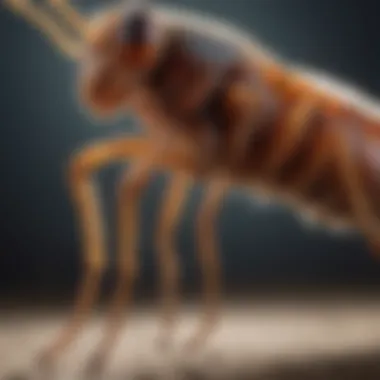
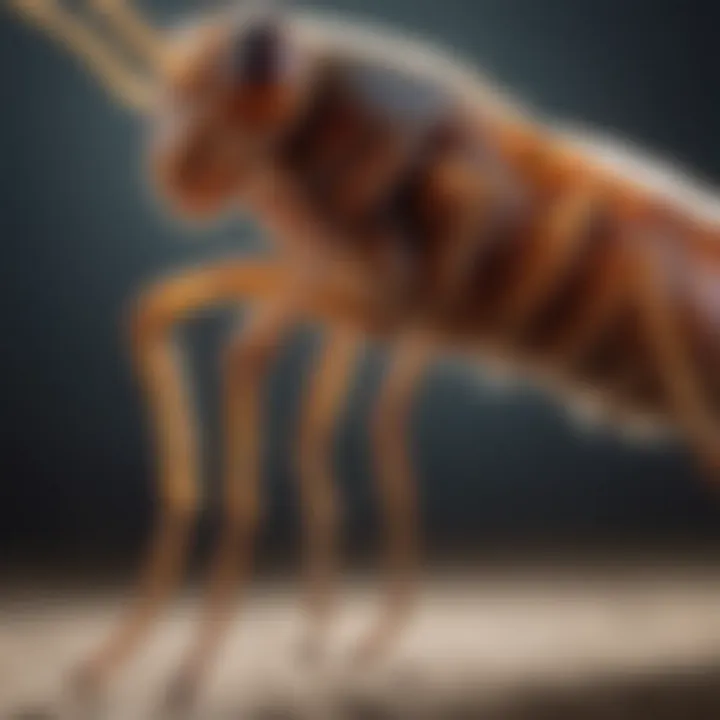
Intro
Fleas are small insects renowned for their extraordinary jumping capabilities. This article delves into the anatomy and physiology that allow these pests to leap several times their own body length. By exploring the unique mechanisms of flea locomotion, we aim to provide valuable insights into their behavior and interaction with their environments. Understanding these factors is not just an academic pursuit; it has practical implications for managing flea infestations in households.
Understanding the Pest
To effectively deal with fleas, it is essential to understand the pest itself. Fleas are tiny, wingless insects belonging to the order Siphonaptera. Their life cycle plays a crucial role in how these organisms proliferate within human environments.
Identification
Fleas are typically dark brown to black, measuring about 1.5 to 3.3 mm in length. They have a laterally compressed body, which allows them to navigate through the fur of animals. The most common species affecting domestic pets include the cat flea, Ctenocephalides felis, and the dog flea, Ctenocephalides canis.
Life Cycle
The life cycle of a flea consists of four distinct stages: 1) egg, 2) larva, 3) pupa, and 4) adult. Understanding this cycle is crucial for effective pest management.
- Egg: Flea eggs are laid on the host animal but often fall off into the environment. They hatch in two to twelve days, producing larvae.
- Larva: The larvae feed on organic material, especially adult flea feces. They emerge from their cocoons after 5 to 14 days, depending on environmental conditions.
- Pupa: The pupal stage can last several days to several months. This stage is where fleas can withstand various conditions, waiting for a host.
- Adult: Adult fleas can live for several weeks to several months and are responsible for causing itching and discomfort.
By understanding how fleas reproduce and develop, one can better approach their control.
Pest Prevention Strategies
Taking measures to prevent fleas from entering the home is vital for maintaining a comfortable living environment. Here are important strategies:
Environment Modification
Keeping the living area clean is crucial. Regular vacuuming of carpets, rugs, and upholstery removes eggs and larvae. Wash pet bedding and coverings frequently in hot water to eliminate infestations.
Physical Barriers
Consider installing mesh screens in windows and doors, which can prevent fleas from entering the home. Keeping pets treated with flea prevention products also serves as a barrier to block fleas from coming indoors.
Control Methods
If an infestation occurs, it is essential to employ effective control methods. There are a variety of options available.
Chemical Control
Insecticides can be useful in eliminating adult fleas and breaking the life cycle. Products containing fipronil and imidacloprid are popular choices for treating pets and their habitats. Always read and follow the label instructions carefully.
Biological Control
Natural predators can also help control fleas. Nematodes, for instance, are microscopic worms that can target flea larvae in the soil. Utilizing such biological methods could be an effective, environmentally friendly alternative to chemical treatments.
"Understanding flea behavior and life cycle is crucial for effective pest management."
Prelims to Flea Behavior
Understanding flea behavior is essential, especially when addressing their adaptability and survival strategies. Fleas, as ectoparasites, have developed unique behaviors that not only ensure their survival but also allow them to thrive in various environments. This section explores the significant factors that motivate their behavior and how these factors influence their jumping abilities.
Overview of Flea Species
Fleas belong to the order Siphonaptera and comprise over 2,500 species. The most commonly encountered fleas in domestic settings include the cat flea (Ctenocephalides felis), dog flea (Ctenocephalides canis), and human flea (Pulex irritans). Each species has adapted to specific hosts, which influences its behavior and ecology. Generally, fleas have a flat body structure that aids in navigating through the fur of their hosts. Some species are highly host-specific, while others exhibit a wider range of adaptability. Understanding these differences can help in pest management strategies, allowing for targeted approaches that consider species behavior.
Significance of Jumping in Survival
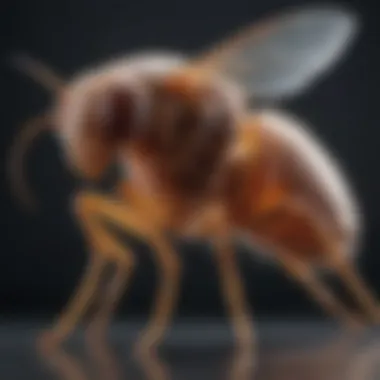
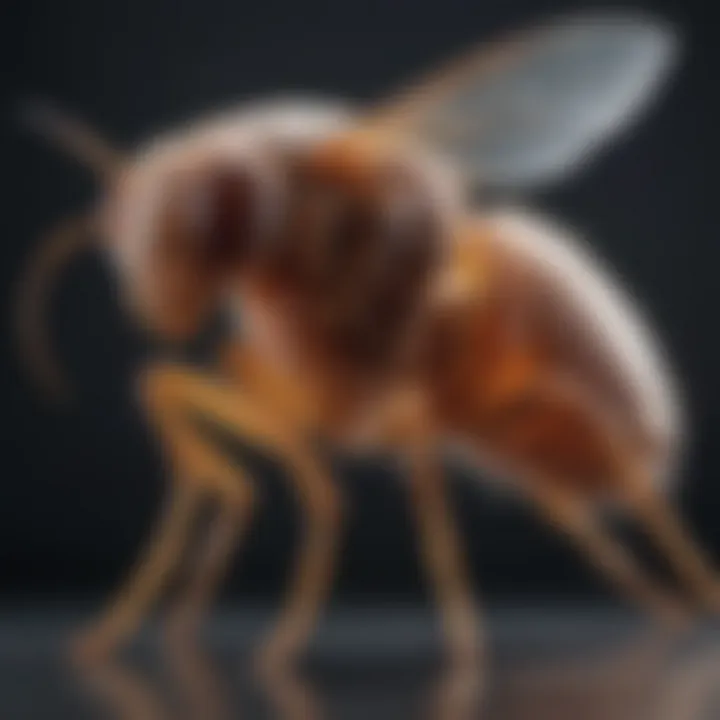
Jumping plays a crucial role in the survival of fleas. They rely on their remarkable jumping abilities to evade predators and find suitable hosts. This locomotion strategy allows fleas to traverse significant distances relative to their size. On average, fleas can jump up to 150 times their body length, a feat that is simply astounding within the insect world. This capability not only helps in escaping threats but also enhances their ability to locate hosts for feeding. The energy-efficient mechanics of their jumps are a result of specialized muscle structures and elastic proteins, which store energy to be rapidly released during their leaps. Through studying these behaviors, we gain insight into flea populations and their dynamics, which is critical for implementing effective pest control measures.
"Fleas are not just pests but also examples of evolutionary success, showcasing impressive adaptations that ensure their survival in diverse environments."
In summary, this exploration of flea behavior highlights their evolutionary adaptations, focusing on their remarkable jumping abilities. By comprehending these aspects, we can develop better strategies to manage flea populations, benefiting both householders and homeowners.
The Anatomy of a Flea
Understanding the anatomy of a flea is crucial in our exploration of its jumping abilities. The specialized body structure and leg mechanics of fleas contribute to their remarkable capacity for leaping great distances, which is vital for their survival. By examining the anatomical features, readers can appreciate how these insects have evolved specific adaptations that optimize their jumping. This knowledge not only informs us about flea biology but also enhances our strategies for pest management, particularly in households.
Body Structure
Fleas possess a streamlined body that is flat from side to side, allowing them to navigate through the fur or feathers of their hosts with ease. The overall shape helps to minimize resistance when they jump or move. Their exoskeleton is hard and can withstand pressure, which is important since they often land on hard surfaces after jumping. This structure contains a variety of sensory organs, allowing fleas to detect environmental changes, which plays a role in their jumping behavior.
The size of a flea typically ranges from 1.5 to 3.3 millimeters in length, making them relatively small but capable of significant movement. Their compact body coupled with their strong leg muscles provides them with the necessary leverage to jump high and far, which is essential for avoiding predators and finding hosts.
Leg Muscles and Mechanics
Muscle Fiber Composition
The muscle fiber composition in fleas is particularly tailored for their jumping capacity. Fleas possess a high proportion of elastic proteins within their leg muscles. These proteins allow for rapid energy storage and release, which are critical in the jumping mechanism. The key characteristic of these muscle fibers is their ability to contract quickly and efficiently, enabling powerful jumps when the flea needs to evade threats or reach a host.
This unique feature of muscle fibers also means that fleas can perform repeated jumps without significant fatigue. Their muscle structure is thus a beneficial aspect of their anatomy; it enables them to be both agile and efficient. However, it can be limiting in terms of how fast they can move laterally, as the focus remains primarily on vertical motion, which is essential for their survival strategy.
Jumping Mechanism
The jumping mechanism of fleas involves a fascinating interaction between their legs and the stored energy in their muscles. When ready to jump, fleas contract their muscles powerfully, using a latch mechanism in their leg structure. This mechanism allows for the rapid release of energy previously stored in the elastic proteins. The resultant force produces a leap that can reach several inches in height, which is impressive relative to their body size.
A notable feature of this mechanism is its efficiency; fleas can achieve such heights with minimal energy expenditure. This advantage means that they can quickly jump away from danger or search for nutrients in their environment, enhancing their survival. However, this focus on vertical jumps means that fleas must carefully consider their landing spots, as miscalculations can lead to predation or difficulty in finding new hosts.
How High Can a Flea Jump?
Understanding how high a flea can jump is pivotal for grasping its overall survival strategies and interactions within its environment. The remarkable jumping ability of fleas signifies not only their physical adaptations but also their behavioral patterns. This knowledge is essential for those looking to manage flea infestations. By knowing the jump height, pest control measures can be tailored effectively, concentrating on high-impact areas where fleas are likely to thrive.
Research Findings on Jump Height
Comparative Analysis with Other Insects
Fleas stand out in the insect kingdom due to their extraordinary jumping abilities. Research indicates that fleas can jump vertically up to 7 inches (approximately 18 cm). This is significant when compared with other insects, such as grasshoppers, which can only jump about 2 feet (approximately 61 cm) horizontally but not vertically. The ability of fleas to leap many times their body length is what makes them a noteworthy subject of study.
The comparison with other insects reveals that while jumping is a common ability in many species, the mechanics are different. This jumping efficiency allows fleas to evade predators swiftly. Their jumps are an evolutionary benefit that aids in survival.
Factors Influencing Jump Height
Several factors influence how high a flea can jump. The physiological makeup of the flea plays a key role. For example, the muscle fiber composition determines the strength and speed of the jump. Environmental conditions also impact jump performance. Cooler temperatures might hinder mobility while warmer conditions can enhance energy storage in their muscles. The availability of suitable surfaces to jump from creates an opportunity for successful leaps. Understanding these factors allows researchers and pest control specialists to identify patterns in flea behavior, thus providing insights into management strategies.
Environmental Considerations
Fleas thrive in specific environmental conditions that amplify their jumping abilities. Humidity levels affect the flea’s physiological functions. A humid environment can stimulate flea activity, leading to increased rates of jumping and breeding. Additionally, surfaces with varied textures can either facilitate or impede their jumps.
Key points include:
- Humidity: Optimal levels support active jumping.
- Surfaces: Rough or uneven surfaces provide better footing for jumps.
- Temperature: Warmer conditions tend to enhance their motor functions.
By considering these environmental elements, one can tailor pest control strategies that align better with flea behavior, ultimately making them more effective.
The Physics of Flea Jumps
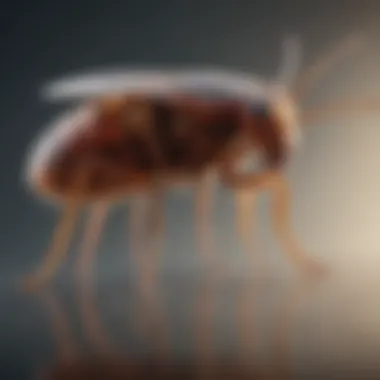
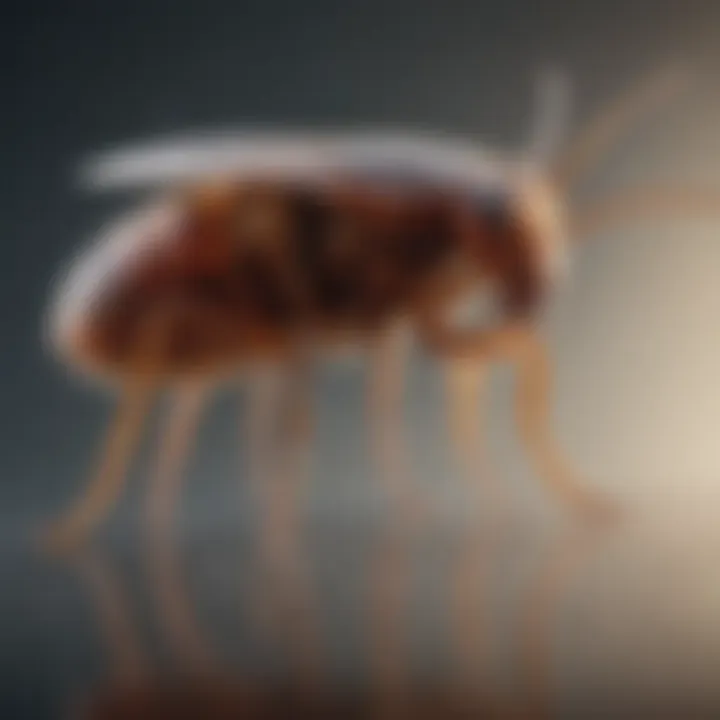
Understanding the physics of flea jumps is fundamental to appreciate how these tiny insects navigate their environment. Fleas have evolved an extraordinary ability to leap, often achieving distances up to 200 times their body length. This section explores how energy is stored and converted during a jump, and the trajectories involved in their remarkable leaps.
Energy Storage and Release
The Role of Elastic Proteins
Elastic proteins play a crucial role in the ability of fleas to jump. These proteins, particularly resilin, are highly elastic and can store vast amounts of energy when compressed. When a flea prepares to jump, its legs bend, compressing these proteins. The energy stored in the resilin is significant because it allows fleas to release rapid bursts of strength necessary for powerful jumps. This property is beneficial as it permits fleas to conserve energy during movement while still achieving remarkable heights and distances.
A key characteristic of elastic proteins like resilin is their capacity to stretch and recoil efficiently. This adaptability makes them ideal for the mechanics of leaping. The unique feature of resilin is its efficient energy conversion capabilities, which allows fleas to jump multiple times in quick succession without exhausting themselves. The advantage of such effective energy storage aligns well with their need to escape predators and find hosts quickly, critical for their survival.
Conversion of Energy to Motion
The conversion of stored energy into motion is an essential aspect of the jumping mechanism in fleas. After storing potential energy in their elastic proteins, fleas release it suddenly, which results in rapid acceleration. When the crest of the leg extends, the energy transitions into kinetic energy, propelling the flea away from its starting point. This impressive conversion process illustrates how fleas manage to achieve significant leverage and propulsion.
The key characteristic here is the speed at which this energy conversion occurs. Fleas can accelerate intensely in just a fraction of a second, enabling them to evade threats. The unique feature of this process is that it occurs within a highly coordinated motion involving muscle contraction and the rapid release of elastically stored energy. This technique serves both advantages and disadvantages; while effective for jumping, it requires finely tuned muscle control and can potentially put stress on their bodily structures if mismanaged.
Trajectory and Distance
The trajectory of a flea's jump directly influences how far it can travel and what obstacles it can navigate. Fleas can alter their jump angles, which assists in navigating around obstacles or towards hosts. The relationship between trajectory and distance is underpinned by physical laws governing movement.
When you observe a flea jump, it often follows a parabolic path. This design helps maximize reach while minimizing energy expenditure. Such efficient mechanics not only facilitate a swift escape from potential threats but also improve their chances of locating hosts for feeding. Understanding these principles is vital for managing flea populations; they can leap into unexpected places, making control challenging.
Fleas exemplify the intersection of biology and physics. Their jumping abilities showcase nature's profound design and efficiency. This knowledge also provides insights into pest control strategies.
By analyzing how fleas jump, we can unlock ideas for eco-friendly pest control techniques. For instance, understanding their jumping mechanics might aid in designing traps that account for their unique leap patterns.
The understanding of the physics behind flea jumps is vital—not just for scientists but for anyone looking to manage these pests. By integrating this knowledge it can lead to innovative solutions in controlling flea populations.
Behavioral Aspects of Jumping
Understanding the behavioral aspects of jumping in fleas provides crucial insight into their survival mechanisms. Fleas rely on their remarkable jumping abilities for several essential tasks. These include avoiding predators and locating hosts for feeding. Each of these elements plays a significant role in a flea’s life cycle and influences its behavior in complex environments.
Predator Evasion
Fleas are prey for various animals, making effective escape tactics vital. Their ability to jump with agile precision allows them to evade predators swiftly. When threatened, fleas can leap in a split second, covering great distances away from danger. This jump can be several hundred times their body length, a survival strategy that enables them to escape ground-based threats quickly.
"The flea’s jump mechanics are not only a spectacle of physiology but also a critical adaptation for survival."
This immediate reaction to potential danger is a combination of instinct and evolved behavior that provides flea populations with a means to dodge threats effectively. Moreover, observational studies indicate that fleas tend to exhibit cautious behavior when they sense predators nearby. Their ability to leap allows them to maintain distance, enhancing their chances of survival against predators such as ants and spiders.
Finding Hosts
Another significant aspect of jumping behavior in fleas is its role in locating hosts. Adult fleas feed on the blood of their hosts, which can include mammals and birds. Jumping facilitates their movement from one environment to another, allowing them to reach hosts efficiently. When a flea detects a potential host nearby—through vibrations or body heat—it utilizes its jumping capabilities to close the distance quickly.
The search for a host is often a strategic behavior. Fleas can land on a host even if they are several inches away, making their jumping prowess vital in ensuring successful feeding. This behavior enhances their reproductive success, as a healthy flea can produce numerous offspring.
In summary, the behavioral aspects of jumping in fleas are critical for their survival and reproductive success. By understanding these behaviors, homeowners can gain insights into controlling flea populations effectively. Recognizing how fleas interact with their environment shapes pest management strategies and informs preventive measures.
Comparative Jumping Mechanisms in Insects
Jumping abilities in insects are a fascinating area of study within entomology. While fleas are renowned for their impressive leaps, other insects exhibit remarkable jumping mechanisms as well. Understanding these mechanisms is key not just to the biology of each species, but to the broader ecological interactions and survival strategies present in nature. By examining the mechanisms that govern jumping in various insects, we gain insights into evolutionary adaptations that enhance survival and reproductive success.
Analysis of Other Jumping Insects
Many insects possess specialized adaptations that enable efficient and effective jumping. For example, grasshoppers utilize a different biomechanical strategy compared to fleas. Grasshoppers rely on long hind legs that store energy in elastic structures during preparation for a jump. When released, this stored energy allows for explosive movement. Similarly, the froghopper can achieve incredible heights by rapidly contracting its powerful hind leg muscles.
In contrast, fleas have evolved the ability to jump proportionally larger distances relative to their body size. Some other insect species known for their jumping abilities include:
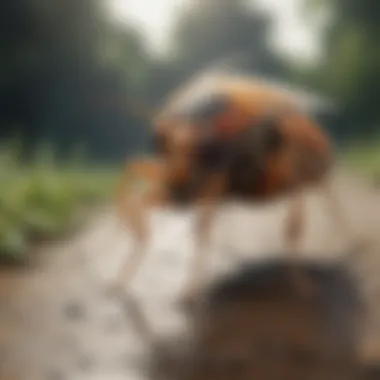
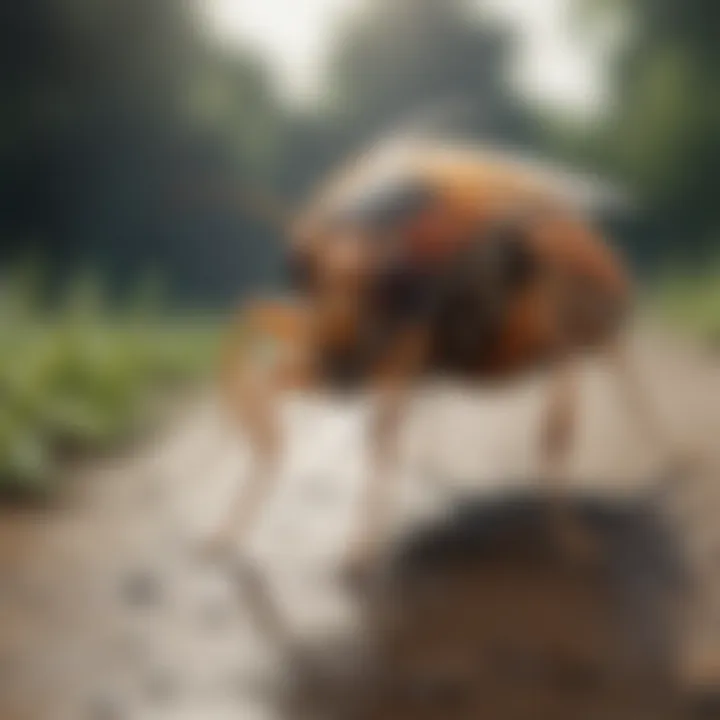
- Katydids: Known for their long jumping legs and ability to swiftly change direction.
- Crickets: Use jumping for both locomotion and escaping predators.
- Spiders (such as jumping spiders): Not technically insects, but their jumping mechanics represent unique evolutionary paths related to hunting behaviors.
Research on these insects reveals that jumping strategies are often closely connected to habitat and lifestyle. Insects that need to escape predators tend to develop more dynamic, forceful jumping mechanisms, while those that move through dense vegetation may evolve different strategies.
Evolutionary Benefits of Jumping
The evolution of jumping mechanisms is crucial for the survival of various insect species. The benefits derived from jumping are multifaceted:
- Predator Evasion: Jumping allows insects to quickly escape threats. For example, a flea's rapid leap can evade a passing hand or a curious pet's paw.
- Finding Food: Insects, including fleas, may jump to reach higher ground or to navigate through obstacles while searching for food sources.
- Mate Attraction: Some insects use jumping as part of courtship displays to attract mates.
Despite these adaptations, the trade-offs include energy expenditure and the risk of landing in less favorable locations. Understanding these capacities provides insight into behavioral ecology, emphasizing the relationship between morphology and function.
"Comparative studies of jumping capabilities in insects reveal hidden connections among various species' survival strategies and their environmental adaptations."
Analyzing the jumping mechanisms in fleas alongside other insects gives a comprehensive perspective on evolution. It emphasizes how environmental pressures shape the biological features of different species. This knowledge is not only academically intriguing but also provides practical insights applicable to pest management and ecological conservation.
Implications for Pest Control Strategies
Understanding flea jumping abilities is essential for developing efficient pest control strategies. Fleas are notorious for their quick jumps, enabling them to evade threats and locate hosts for feeding. These behaviors must be considered when creating effective management plans. By focusing on their jumping mechanisms, one can devise targeted strategies that disrupt their natural behavior, ultimately reducing flea populations.
Understanding Flea Behavior for Effective Management
Targeting Jumping Mechanisms
Targeting jumping mechanisms is key in flea management. By disrupting the mechanics that allow fleas to jump, pest control measures can be more effective. A significant characteristic of this approach is the ability to identify and exploit the biomechanics of flea jumps.
One unique feature of targeting jumping mechanisms is the use of specific barriers and traps that hinder their movement. This method can be advantageous because it is less harmful to the environment compared to chemical approaches. However, one must consider that while it effectively reduces populations, it may not eliminate all fleas.
Preventive Measures
Preventive measures are crucial aspects of flea management. One key characteristic of these measures is creating unfavorable conditions for fleas to thrive. For instance, maintaining cleanliness in living areas reduces the chances of flea infestation.
This approach is beneficial because it focuses on proactive rather than reactive strategies. A unique feature of preventive measures is their reliance on routine maintenance. Regularly treating pets and cleaning household items disrupts flea life cycles. Nonetheless, preventive measures require consistent effort, and some people might find it challenging to maintain thorough cleaning routines.
Eco-Friendly Pest Control Techniques
Choosing eco-friendly pest control techniques is increasingly important for homeowners. Many families prefer non-toxic approaches to tackle flea infestations while minimizing harm to the environment. These methods may include utilizing natural repellents and insect growth regulators, which disrupt flea development without chemical residues.
Incorporating eco-friendly techniques aligns with a growing awareness of sustainability. Homeowners may see this as a valuable addition to their daily routines, fostering a healthier home. While eco-friendly solutions may take longer to show results compared to traditional chemicals, their long-term benefits often outweigh the initial delays.
Closure: The Significance of Jumping in Fleas
The jumping ability of fleas plays a crucial role in their survival and adaptation to various environments. This conclusion wraps up the findings discussed throughout the article, detailing why understanding these capabilities is important. Not only does the jump facilitate predator evasion, but it also enables fleas to find hosts from which they can feed. Therefore, this locomotion is not just an interesting biological feature; it has direct implications for their life cycle.
Given the pest status of fleas in homes, their jumping ability poses unique challenges for pest control strategies. Conventional methods may not effectively target these agile insects, making the knowledge of their mechanics essential for developing better management tactics.
In summary, jumping is a primary tool for fleas that enhances their survival, reproduction, and interaction within their ecosystems. Understanding this feature better can lead to more effective methods for controlling flea populations in household environments and improving quality of life for pet owners.
Summary of Key Insights
Several insights are derived from the earlier sections of this article:
- Fleas can jump extraordinarily high and far relative to their body size, showcasing an evolutionary advantage.
- The anatomy and physiology, especially regarding their legs and specialized muscles, are designed specifically for explosive movements.
- Jumping is vital for both finding hosts and avoiding predators, emphasizing its dual significance in flea behavior and ecology.
- Control strategies must adapt to the unique jumping capabilities of fleas in order to effectively manage infestations.
By synthesizing these insights, it is clear that the jumping abilities of fleas have far-reaching implications beyond mere curiosity.
Future Directions for Research
Future research on flea jumping ability could explore various avenues:
- Mechanics of Jumping: Further studying the biomechanical aspects might reveal improved methods for pest control or even inspire innovations in other fields, such as robotics.
- Behavioral Studies: Examining how environmental factors influence jumping behavior can clarify how fleas interact with ecological changes.
- Genetic Research: Investigating the genetic basis of jumping-related adaptations may unlock more insights into the evolutionary history of fleas and their relatives.
Advancements in these areas can significantly contribute to the overall understanding of flea behavior, ecology, and pest management. The interdisciplinary correlation between insect physiology, behavior, and pest control practices could enhance both academic and practical approaches to tackling fleas in human environments.







